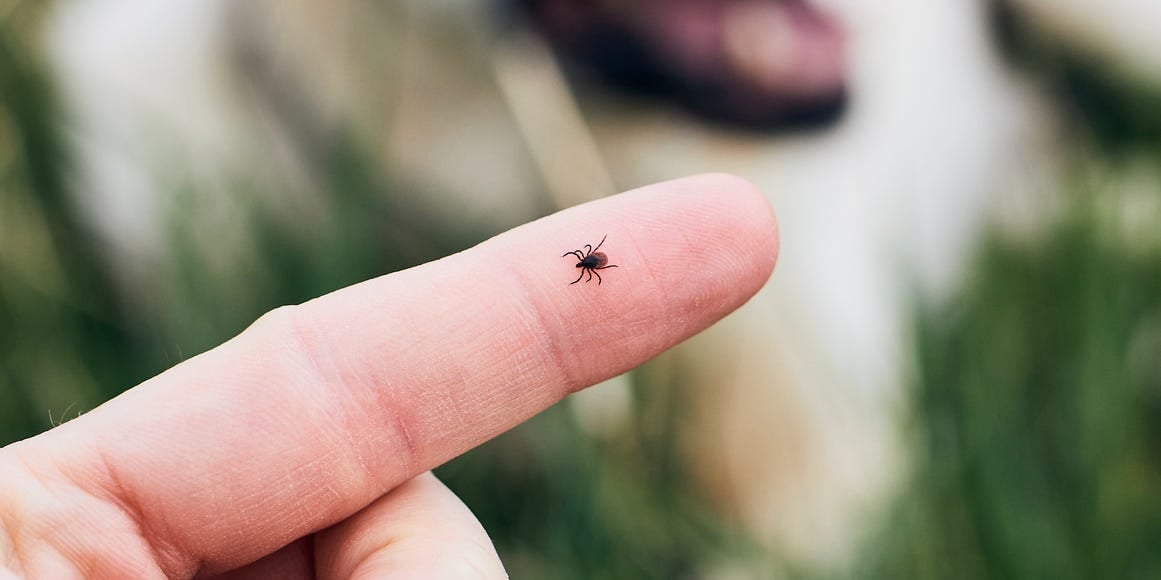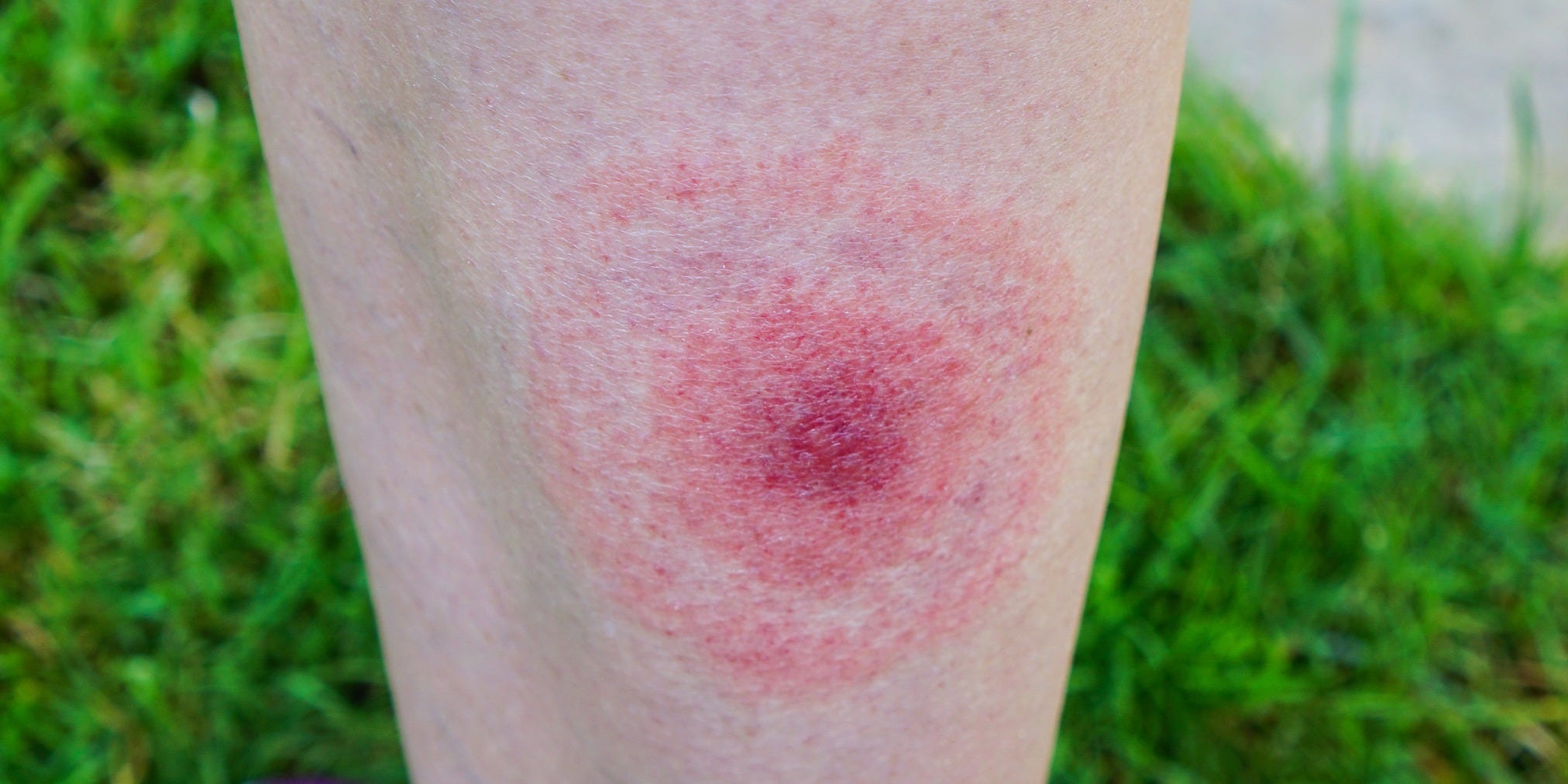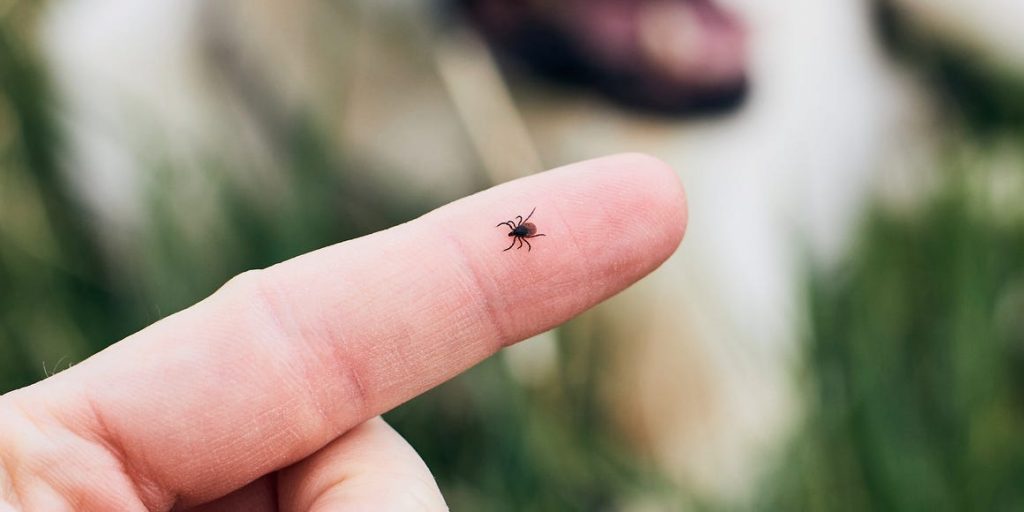
Chalabala/Getty Images
- A tick bite will become red and itchy within a few days and sometimes cause hives or swelling.
- Tick bites can sometimes cause tick-borne illnesses like Lyme disease and Tularemia.
- To treat a tick bite, remove the tick immediately and apply a local anesthetic spray.
- Visit Insider's Health Reference library for more advice.
Tick bites are notoriously difficult to spot. That's because ticks have a trick up their sleeves. When they bite you, the tick saliva acts as a painkiller, numbing the area so you don't feel it.
As a result, you may not always notice if a tick has bitten you until it falls off, or if you have an allergic reaction.
Nevertheless, some types of ticks can pass harmful diseases on to humans, and it's important to be aware of the signs of tick-borne illness, which can appear anywhere from three to 30 days after a tick bite.
Here's how to recognize tick bites and tick-borne illnesses, when to seek medical attention, and how to prevent them in the first place.
What are ticks?
Ticks are small, blood-sucking parasites that live outside in grass, leaf piles, trees, and shrubs. They are a type of arachnid, closely related to spiders.
When a tick bites, it will attach to the skin of people or animals, feeding on the blood of whatever host it finds.
People encounter ticks outdoors, usually in wooded, grassy or bushy areas. While tick bites can occur year-round, you're more likely to come into contact with them during warmer weather, from April to September, according to the Centers for Disease Control (CDC).
Tick bite symptoms
Tick bites are nearly impossible to feel, says Andres Romero, MD, infectious disease specialist at Providence Saint John's Health Center.
Romero advises removing your clothes after spending time in grassy or wooded areas and checking for ticks, paying close attention to places where your skin folds. Because once a tick gets on your body, it's likely to migrate to warm and moist areas like your armpit or groin.
If a tick does bite you and you don't notice, it will fall off on its own after a few days. Your skin will likely become red and itchy at the spot after the tick falls off. Many people don't realize they've been bitten by a tick until this point.
However, others can experience an allergic reaction to a tick bite, indicated by the following symptoms once the tick bites you:
- Rash
- Hives
- Pain, swelling, or a burning sensation at the bite site
According to Romero, most people should be able to manage these symptoms at home with an over-the-counter antihistamine medication, like Benadryl, but it never hurts to get a doctor's guidance if you're worried your reaction might be severe.
If you have trouble breathing, you should seek medical attention immediately, as this can be a sign of a severe allergic reaction known as anaphylaxis.
Tick-borne illness symptoms

anakopa/Getty Images
Some types of ticks can transmit diseases to humans and animals. In most cases, a tick needs to be attached and feeding for at least 24 hours to transmit disease, Romero says.
Examples of tick-borne illnesses include:
- Lyme Disease. Signs include a circular rash within three to 30 days of a tick bite, followed by the onset of a fever. The infection can spread to the joints, heart and nervous system, and if left untreated, it can cause long-term joint pain.
- Rocky Mountain Spotted Fever (RMSF). Signs include a fever, muscle aches, headache, and a rash of flat, pink, non-itchy spots that appear on the wrists, forearms, and ankles. RMSF can be fatal if not treated with antibiotics within five days of illness.
- Southern Tick-Associated Rash Illness (STARI). Signs include a circular rash similar to the one associated with Lyme Disease. Other symptoms include fever, headache and joint pain.
- Tularemia. Signs include a skin ulcer that appears at the tick bite site, and swelling of lymph glands in the armpit or groin. It can be life-threatening without treatment, but is usually treated effectively with antibiotics, according to the CDC.
Not all types of ticks carry disease. You may be more at risk for tick-borne illness depending on where you live.
For example, the ticks that cause Rocky Mountain spotted fever are predominantly located in the Northwest region of the United States, and the Western blacklegged tick, which can transmit Lyme disease, is predominant in northern California.
Early recognition and treatment decrease the risk of serious complications from all of these illnesses, Romero says. You should consult a doctor if you develop a fever or any of these other symptoms after a tick bite.
How to prevent tick bites
The best way to avoid tick-borne illnesses is to protect yourself against ticks in the first place. Some best practices for decreasing your risk of tick exposure include:
- Wear protective clothing. For example, Romero suggests covering your ankles if you're going to be out hiking, since ticks are likely to come into contact with you on the ground.
- Use an insect repellent registered by the Environmental Protection Agency, that contains DEET - the most common active ingredient in insect repellent products. Studies have shown DEET to be effective in preventing tick bites.
- Avoid wooded or bushy areas with tall grass, and walk in the center of trails when hiking or in the woods.
- When you do come inside, thoroughly check your body and clothing for ticks. You can tumble dry clothes on high heat for 10 minutes to kill ticks.
- Shower after being outside. If you do have a tick on you, it may not attach itself right away and showering can wash away any unattached ticks.
How to treat a tick bite
It's important to always check for ticks after being outside, as the prompt removal of a tick is the best treatment against illness or infection. For more information, follow these 6 simple steps to remove a tick correctly.
After removal, or once the tick falls off, the bite site can become red and itchy. You may want to use calamine lotion to relieve itching, or a local anesthetic spray that contains benzocaine to reduce any pain at the site.
If you do develop signs of a tick-borne illness, your doctor will likely prescribe an antibiotic, such as doxycycline or amoxicillin. This can help treat an illness like Lyme disease and prevent more severe symptoms from occurring.
Antibiotics are the standard form of treatment for tick-borne illness, and they are very effective when used properly.
For Rocky Mountain Spotted Fever, you may only need to use antibiotics for a week, but for Lyme Disease, you could take them for two to three weeks in order to treat your condition.
The length of time you may need to take antibiotics will also depend on how early you catch your illness and seek treatment. Overall, for all tick-borne diseases, the sooner you seek medical attention, the better.
Insider's takeaway
While tick bites are nearly impossible to feel, they can lead to tick-borne illnesses like Lyme disease or Rocky Mountain Spotted Fever. This causes symptoms like a rash, fever, or muscle aches. However, if you do contract a tick-borne illness, it can be treated with antibiotics.
To prevent future tick bites, wear protective clothing, avoid wooded, areas, and shower after being outside.
